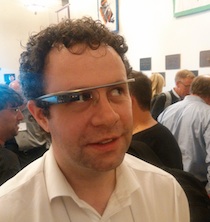Cathal Gurrin
Cathal Gurrin | |
|---|---|
 | |
| Born | 01/06/1975 (40 Years) |
| Nationality | Irish |
| Occupation(s) | Lifelogger and Researcher |
| Known for | Extensive personal database of lifelog images and their interpretation |
Cathal Gurrin is a lifelogger[1][2] and lecturer at the School of Computing, at Dublin City University, a visiting researcher at the University of Tromsø, a visiting scholar at the University of Tsukuba, the director of the Human Media Archives research group and a Funded Investigator in the Insight Centre for Data Analytics[3] His interests include personal analytics and lifelogging. He publishes in a wide range of areas including information retrieval (IR) with a particular focus on how people access information from mobile devices (MHCIR).[4] He has captured a personal digital memory since 2006 using a camera mounted on his chest and created hundreds of millions of other sensor readings.[5]
Early life and education
Cathal attended primary school in Scoil Lorcáin, Kilbarrack and secondary school in St. Fintans High School, Sutton, Dublin 13. He graduated from Dublin City University in 1997 with a degree in Computer Applications.
Research
Cathal has worn a chest mounted camera (a Microsoft SenseCam) since 2006 which takes several pictures every minute, he also records his location (using GPS) and accelerometer data with each image. Cathal now has a database of over 12 million images, and currently produces about a terabyte of personal data a year.[6] Cathal and his researchers use information retrieval algorithms to segment his personal image archive into “events” such as eating, driving, etc. New events are recognized on a daily basis using machine learning algorithms.[7] In an interview with The Economist Cathal said that “If I need to remember where I left my keys, or where I parked my car, or what wine I drank at an event two years ago... the answers should all be there.”[6] It was noted that while searching by date and time is easy, more complex searches within images such as looking for brand names and objects with complex form factors, such as keys, is difficult. The ultimate aim of Cathal's research is to create a search engine to allow complex searches of such image databases.
References
- ^ "Through The Wormhole: Auxiliary Memory". The Science Channel. Retrieved 27 January 2014.
- ^ Baker, Stephen. "This Is Your Lifelog". Business Week (Bloomberg). Retrieved 27 January 2014.
- ^ "INSIGHT Profile - Funded Investigators - Cathal Gurrin". University College Dublin. Retrieved 27 January 2014.
- ^ "Open Access Research Repository - DORAS DCU". Retrieved 27 January 2014.
- ^ "Publications - School of Computing". Dublin City University. Retrieved 27 January 2014.
- ^ a b "The people's panopticon". The Economist. Retrieved 27 January 2014.
- ^ "Cathal Gurrin Research Page". Dublin City University. Retrieved 27 January 2014.
External links
